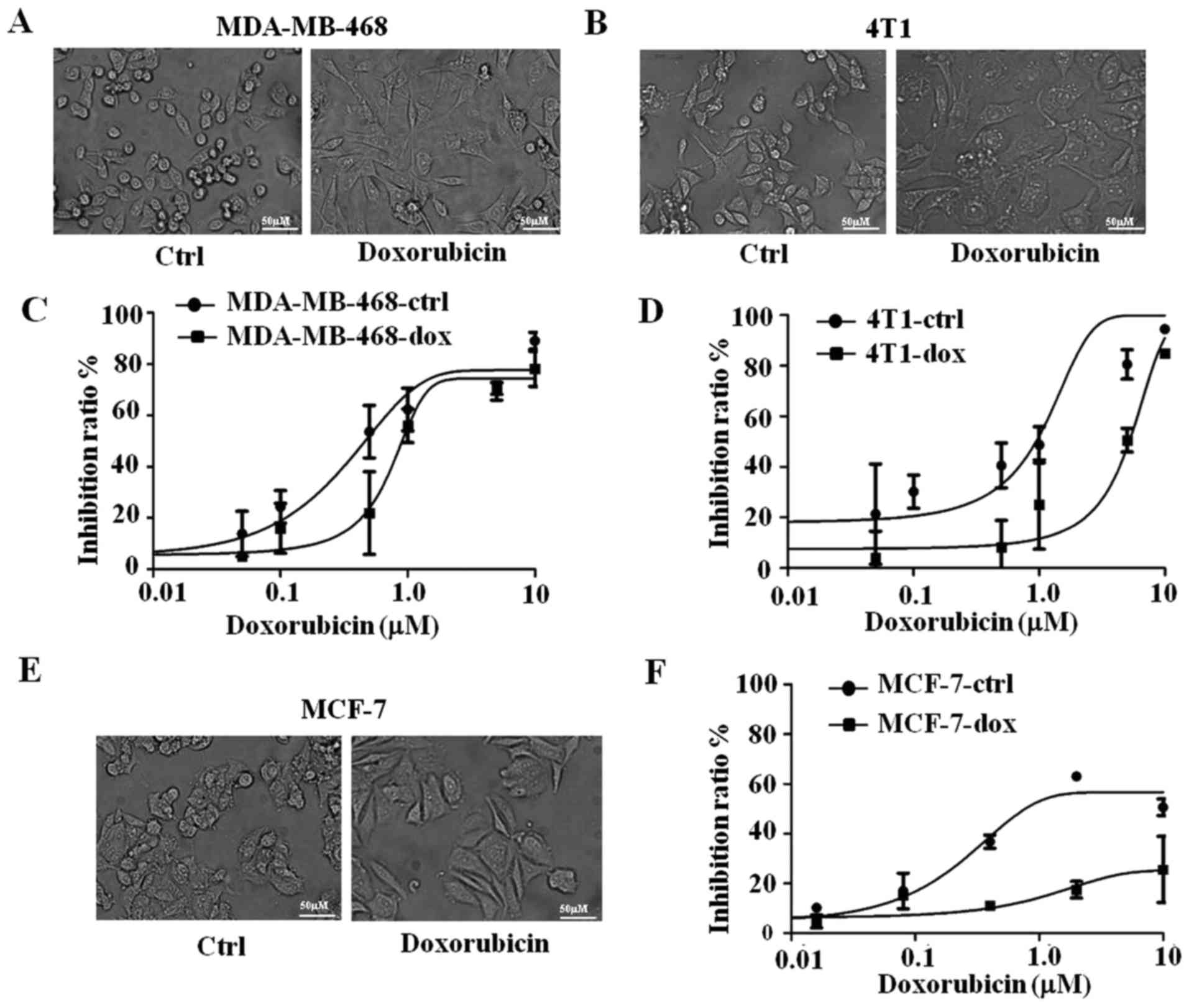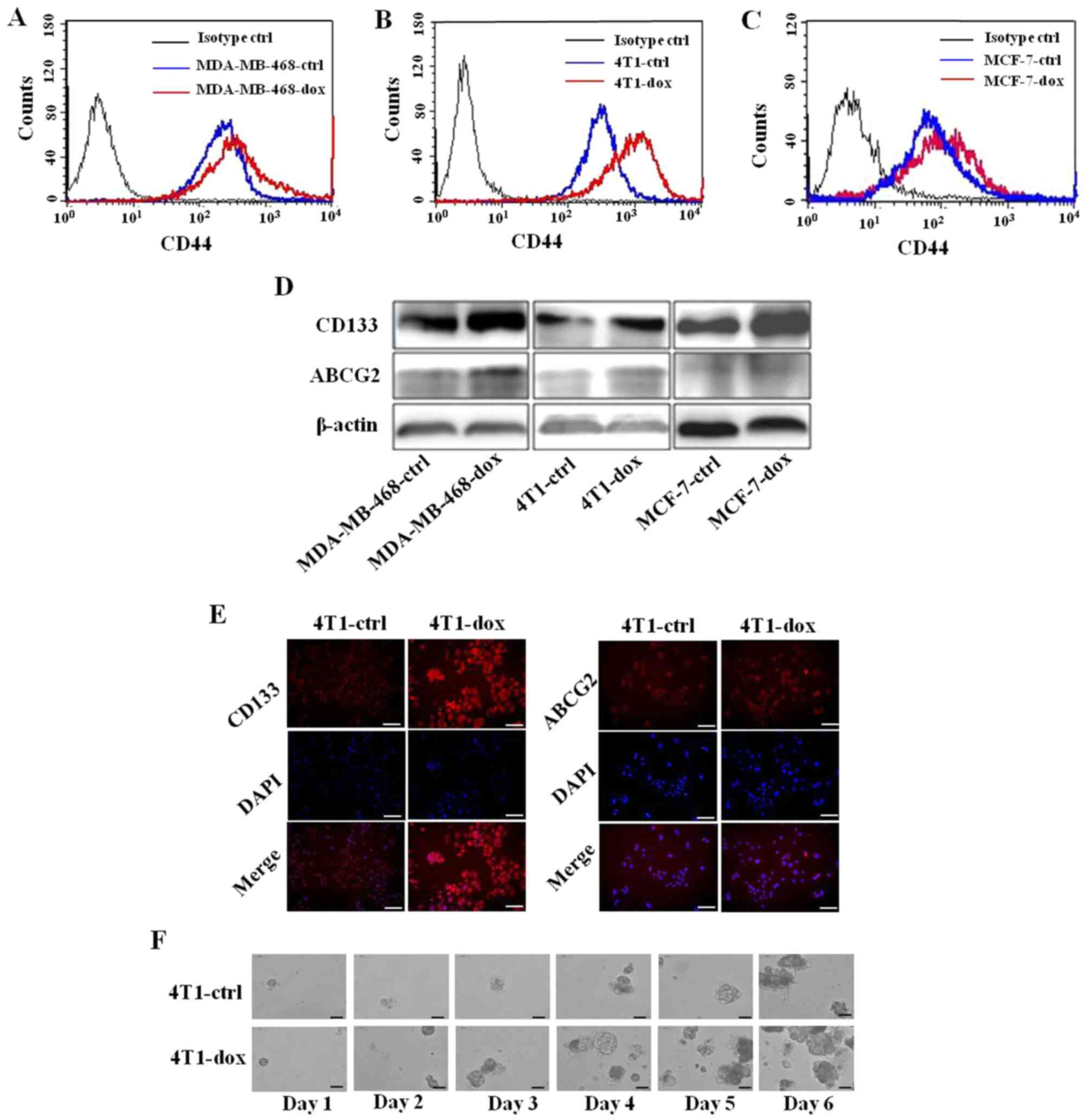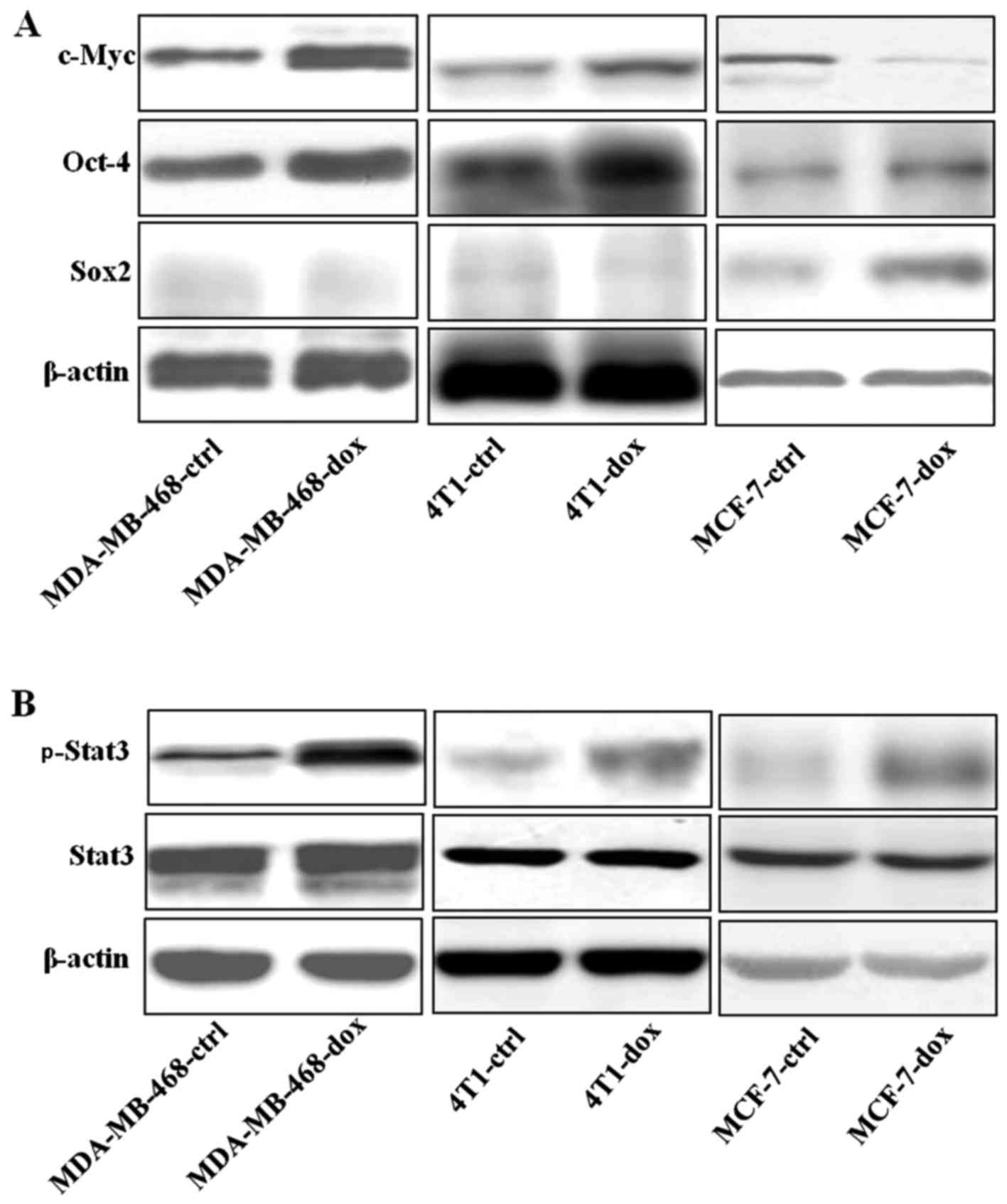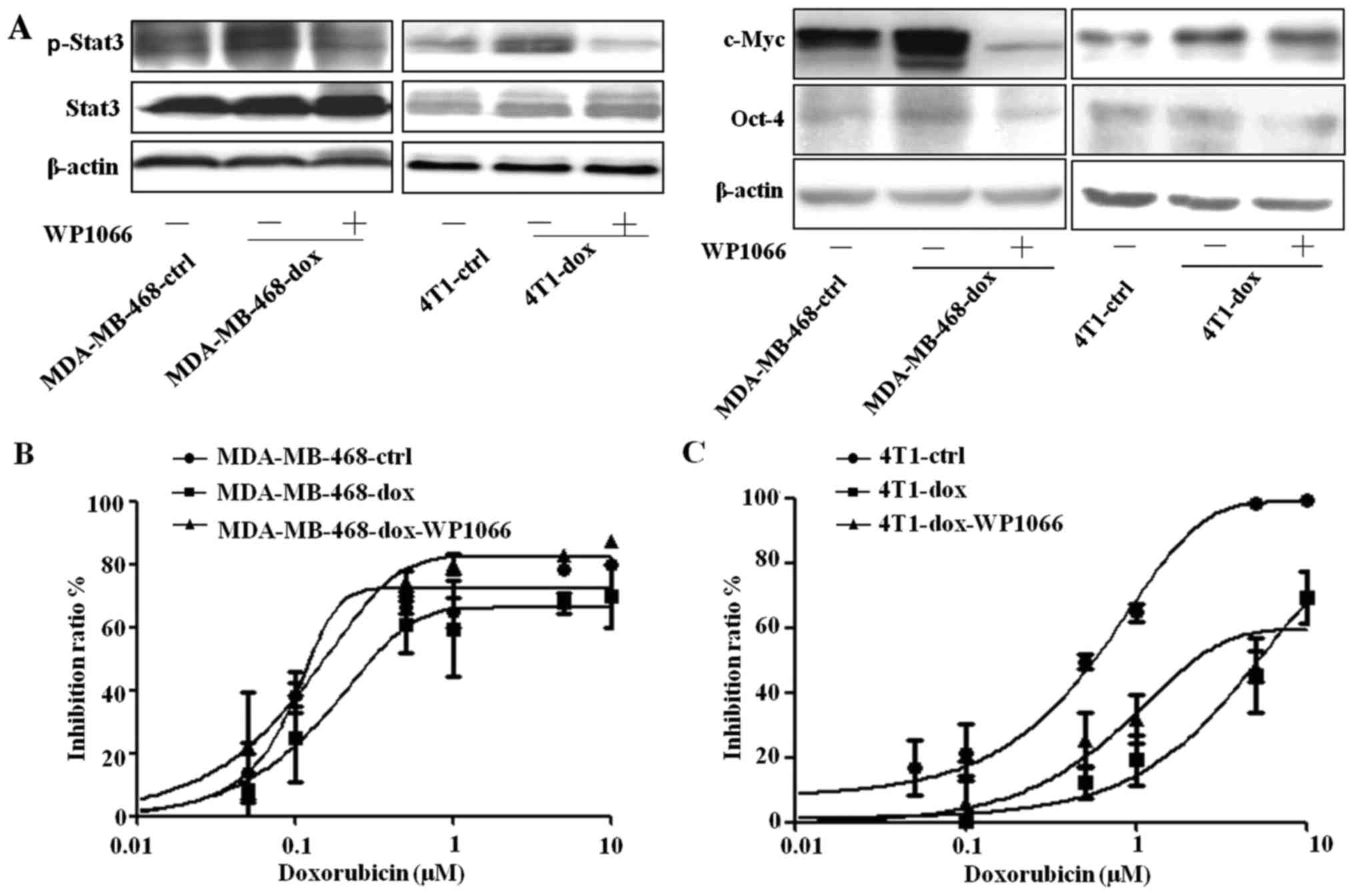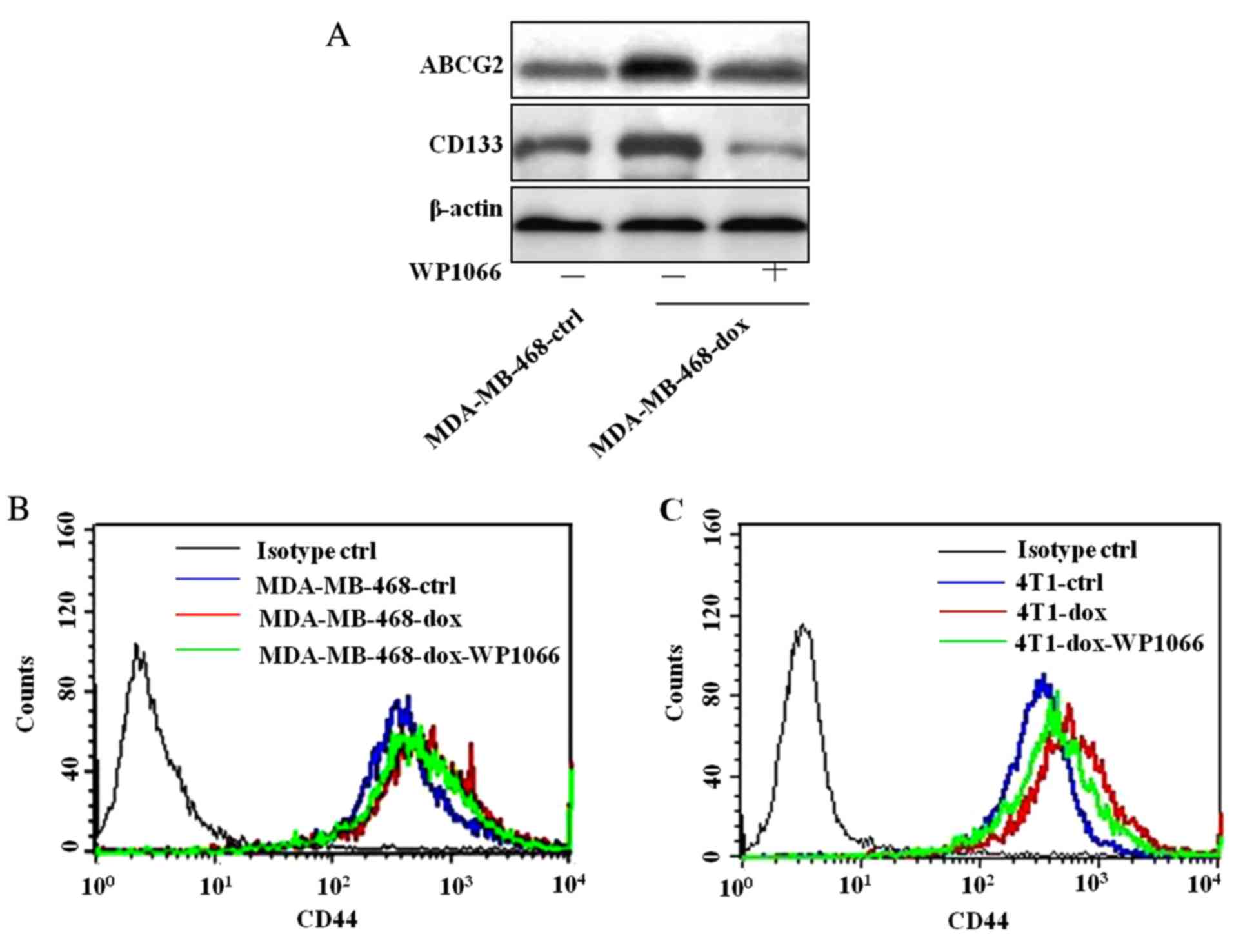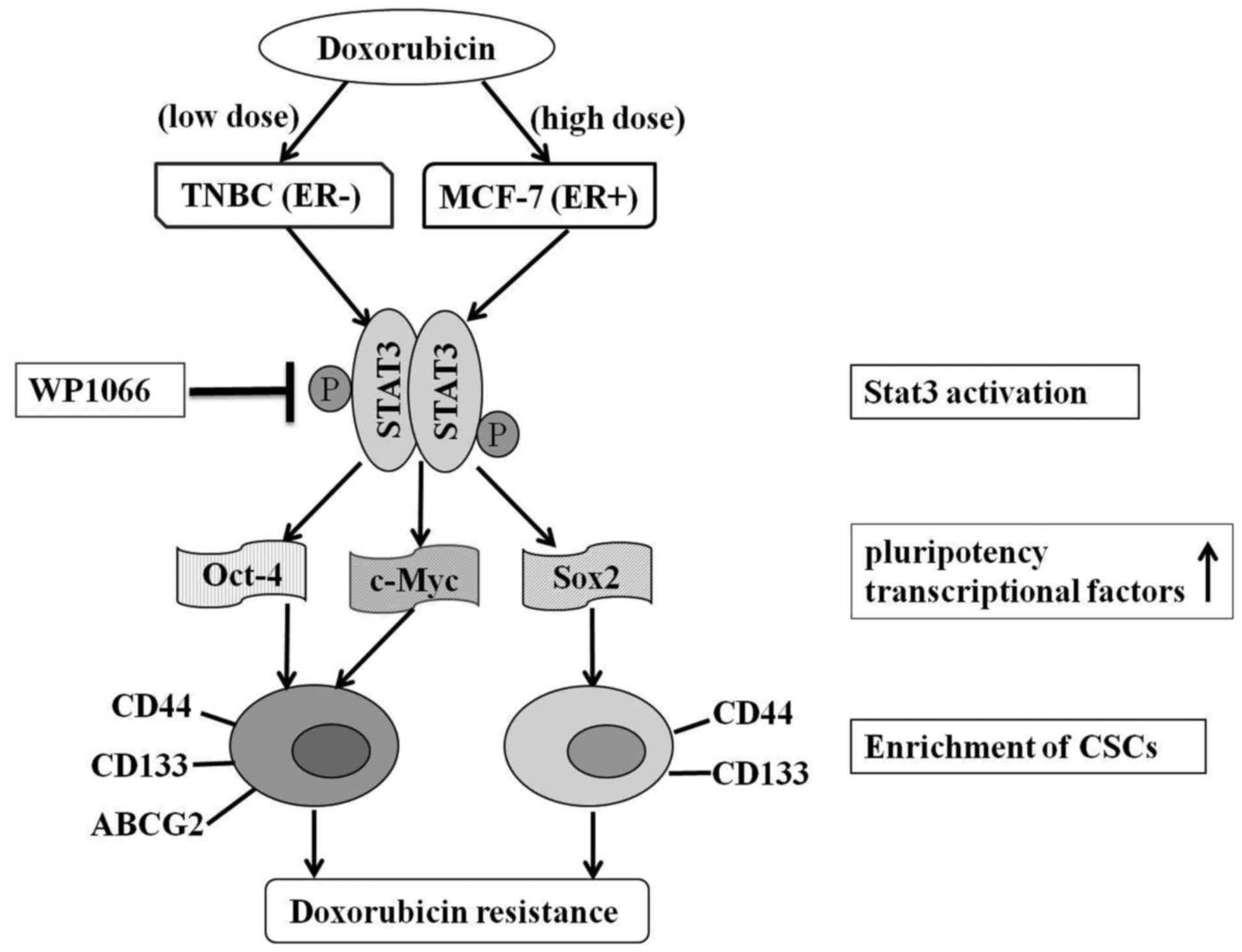|
1
|
Guerriero E, Sorice A, Capone F, Storti G,
Colonna G, Ciliberto G and Costantini S: Combining doxorubicin with
a phenolic extract from flaxseed oil: Evaluation of the effect on
two breast cancer cell lines. Int J Oncol. 50:468–476. 2017.
View Article : Google Scholar : PubMed/NCBI
|
|
2
|
Xue JP, Wang G, Zhao ZB, Wang Q and Shi Y:
Synergistic cytotoxic effect of genistein and doxorubicin on
drug-resistant human breast cancer MCF-7/Adr cells. Oncol Rep.
32:1647–1653. 2014. View Article : Google Scholar : PubMed/NCBI
|
|
3
|
Kim SY, Kang JW, Song X, Kim BK, Yoo YD,
Kwon YT and Lee YJ: Role of the IL-6-JAK1-STAT3-Oct-4 pathway in
the conversion of non-stem cancer cells into cancer stem-like
cells. Cell Signal. 25:961–969. 2013. View Article : Google Scholar : PubMed/NCBI
|
|
4
|
Thiagarajan PS, Hitomi M, Hale JS,
Alvarado AG, Otvos B, Sinyuk M, Stoltz K, Wiechert A,
Mulkearns-Hubert E, Jarrar A, et al: Development of a fluorescent
reporter system to delineate cancer stem cells in triple-negative
breast cancer. Stem Cells. 33:2114–2125. 2015. View Article : Google Scholar : PubMed/NCBI
|
|
5
|
Calcagno AM, Salcido CD, Gillet JP, Wu CP,
Fostel JM, Mumau MD, Gottesman MM, Varticovski L and Ambudkar SV:
Prolonged drug selection of breast cancer cells and enrichment of
cancer stem cell characteristics. J Natl Cancer Inst.
102:1637–1652. 2010. View Article : Google Scholar : PubMed/NCBI
|
|
6
|
Wang H, Agarwal P, Zhao S, Yu J, Lu X and
He X: Combined cancer therapy with hyaluronan-decorated
fullerene-silica multifunctional nanoparticles to target cancer
stem-like cells. Biomaterials. 97:62–73. 2016. View Article : Google Scholar : PubMed/NCBI
|
|
7
|
Zhu T, Li LL, Xiao GF, Luo QZ, Liu QZ, Yao
KT and Xiao GH: Berberine Increases Doxorubicin Sensitivity by
Suppressing STAT3 in Lung Cancer. Am J Chin Med. 43:1487–1502.
2015. View Article : Google Scholar : PubMed/NCBI
|
|
8
|
Rueff J and Rodrigues AS: Cancer Drug
Resistance: A Brief Overview from a Genetic Viewpoint. Methods Mol
Biol. 1395:1–18. 2016. View Article : Google Scholar : PubMed/NCBI
|
|
9
|
Moitra K, Lou H and Dean M: Multidrug
efflux pumps and cancer stem cells: Insights into multidrug
resistance and therapeutic development. Clin Pharmacol Ther.
89:491–502. 2011. View Article : Google Scholar : PubMed/NCBI
|
|
10
|
Sun FF, Hu YH, Xiong LP, Tu XY, Zhao JH,
Chen SS, Song J and Ye XQ: Enhanced expression of stem cell markers
and drug resistance in sphere-forming non-small cell lung cancer
cells. Int J Clin Exp Pathol. 8:6287–6300. 2015.PubMed/NCBI
|
|
11
|
Karthik GM, Ma R, Lövrot J, Kis LL, Lindh
C, Blomquist L, Fredriksson I, Bergh J and Hartman J: mTOR
inhibitors counteract tamoxifen-induced activation of breast cancer
stem cells. Cancer Lett. 367:76–87. 2015. View Article : Google Scholar : PubMed/NCBI
|
|
12
|
Qiao S, Zhao Y, Geng S, Li Y, Hou X, Liu
Y, Lin FH, Yao L and Tian W: A novel double-targeted nondrug
delivery system for targeting cancer stem cells. Int J
Nanomedicine. 11:6667–6678. 2016. View Article : Google Scholar : PubMed/NCBI
|
|
13
|
Ma S, Lee TK, Zheng BJ, Chan KW and Guan
XY: CD133+ HCC cancer stem cells confer chemoresistance
by preferential expression of the Akt/PKB survival pathway.
Oncogene. 27:1749–1758. 2008. View Article : Google Scholar
|
|
14
|
Chen X, Lingala S, Khoobyari S, Nolta J,
Zern MA and Wu J: Epithelial mesenchymal transition and hedgehog
signaling activation are associated with chemoresistance and
invasion of hepatoma subpopulations. J Hepatol. 55:838–845. 2011.
View Article : Google Scholar : PubMed/NCBI
|
|
15
|
Gopalan A, Yu W, Sanders BG and Kline K:
Eliminating drug resistant breast cancer stem-like cells with
combination of simvastatin and gamma-tocotrienol. Cancer Lett.
328:285–296. 2013. View Article : Google Scholar
|
|
16
|
Williams KE, Bundred NJ, Landberg G,
Clarke RB and Farnie G: Focal adhesion kinase and Wnt signaling
regulate human ductal carcinoma in situ stem cell activity and
response to radiotherapy. Stem Cells. 33:327–341. 2015. View Article : Google Scholar
|
|
17
|
Ma L, Liu T, Jin Y, Wei J, Yang Y and
Zhang H: ABCG2 is required for self-renewal and chemoresistance of
CD133-positive human colorectal cancer cells. Tumour Biol.
37:12889–12896. 2016. View Article : Google Scholar : PubMed/NCBI
|
|
18
|
Zhao D, Pan C, Sun J, Gilbert C,
Drews-Elger K, Azzam DJ, Picon-Ruiz M, Kim M, Ullmer W, El-Ashry D,
et al: VEGF drives cancer-initiating stem cells through
VEGFR-2/Stat3 signaling to upregulate Myc and Sox2. Oncogene.
34:3107–3119. 2015. View Article : Google Scholar
|
|
19
|
Sainz B Jr and Heeschen C: Standing out
from the crowd: Cancer stem cells in hepatocellular carcinoma.
Cancer Cell. 23:431–433. 2013. View Article : Google Scholar : PubMed/NCBI
|
|
20
|
Yu F, Yao H, Zhu P, Zhang X, Pan Q, Gong
C, Huang Y, Hu X, Su F, Lieberman J, et al: let-7 regulates self
renewal and tumorigenicity of breast cancer cells. Cell.
131:1109–1123. 2007. View Article : Google Scholar : PubMed/NCBI
|
|
21
|
Bloushtain-Qimron N, Yao J, Snyder EL,
Shipitsin M, Campbell LL, Mani SA, Hu M, Chen H, Ustyansky V,
Antosiewicz JE, et al: Cell type-specific DNA methylation patterns
in the human breast. Proc Natl Acad Sci USA. 105:14076–14081. 2008.
View Article : Google Scholar : PubMed/NCBI
|
|
22
|
Li X, Lewis MT, Huang J, Gutierrez C,
Osborne CK, Wu MF, Hilsenbeck SG, Pavlick A, Zhang X, Chamness GC,
et al: Intrinsic resistance of tumorigenic breast cancer cells to
chemotherapy. J Natl Cancer Inst. 100:672–679. 2008. View Article : Google Scholar : PubMed/NCBI
|
|
23
|
Kim RJ, Kim SR, Roh KJ, Park SB, Park JR,
Kang KS, Kong G, Tang B, Yang YA, Kohn EA, et al: Ras activation
contributes to the maintenance and expansion of Sca-1pos cells in a
mouse model of breast cancer. Cancer Lett. 287:172–181. 2010.
View Article : Google Scholar
|
|
24
|
Lu CS, Shieh GS, Wang CT, Su BH, Su YC,
Chen YC, Su WC, Wu P, Yang WH, Shiau AL, et al:
Chemotherapeutics-induced Oct4 expression contributes to drug
resistance and tumor recurrence in bladder cancer. Oncotarget.
8:30844–30858. 2017.
|
|
25
|
Kinugasa Y, Matsui T and Takakura N: CD44
expressed on cancer-associated fibroblasts is a functional molecule
supporting the stemness and drug resistance of malignant cancer
cells in the tumor microenvironment. Stem Cells. 32:145–156. 2014.
View Article : Google Scholar : PubMed/NCBI
|
|
26
|
Hu T, Liu S, Breiter DR, Wang F, Tang Y
and Sun S: Octamer 4 small interfering RNA results in cancer stem
cell-like cell apoptosis. Cancer Res. 68:6533–6540. 2008.
View Article : Google Scholar : PubMed/NCBI
|
|
27
|
Ham SL, Joshi R, Luker GD and Tavana H:
Engineered Breast Cancer Cell Spheroids Reproduce Biologic
Properties of Solid Tumors. Adv Healthc Mater. 5:2788–2798. 2016.
View Article : Google Scholar : PubMed/NCBI
|
|
28
|
Han YK, Lee JH, Park GY, Chun SH, Han JY,
Kim SD, Lee J, Lee CW, Yang K and Lee CG: A possible usage of a
CDK4 inhibitor for breast cancer stem cell-targeted therapy.
Biochem Biophys Res Commun. 430:1329–1333. 2013. View Article : Google Scholar
|
|
29
|
Blacking TM, Waterfall M and Argyle DJ:
CD44 is associated with proliferation, rather than a specific
cancer stem cell population, in cultured canine cancer cells. Vet
Immunol Immunopathol. 141:46–57. 2011. View Article : Google Scholar : PubMed/NCBI
|
|
30
|
Fang XJ, Jiang H, Zhu YQ, Zhang LY, Fan QH
and Tian Y: Doxorubicin induces drug resistance and expression of
the novel CD44st via NF-κB in human breast cancer MCF-7 cells.
Oncol Rep. 31:2735–2742. 2014. View Article : Google Scholar : PubMed/NCBI
|
|
31
|
Yae T, Tsuchihashi K, Ishimoto T, Motohara
T, Yoshikawa M, Yoshida GJ, Wada T, Masuko T, Mogushi K, Tanaka H,
et al: Alternative splicing of CD44 mRNA by ESRP1 enhances lung
colonization of metastatic cancer cell. Nat Commun. 3:8832012.
View Article : Google Scholar : PubMed/NCBI
|
|
32
|
Croker AK, Goodale D, Chu J, Postenka C,
Hedley BD, Hess DA and Allan AL: High aldehyde dehydrogenase and
expression of cancer stem cell markers selects for breast cancer
cells with enhanced malignant and metastatic ability. J Cell Mol
Med. 13:2236–2252. 2009. View Article : Google Scholar
|
|
33
|
Dalerba P, Dylla SJ, Park IK, Liu R, Wang
X, Cho RW, Hoey T, Gurney A, Huang EH, Simeone DM, et al:
Phenotypic characterization of human colorectal cancer stem cells.
Proc Natl Acad Sci USA. 104:10158–10163. 2007. View Article : Google Scholar : PubMed/NCBI
|
|
34
|
Zhang G, Wang Z, Luo W, Jiao H, Wu J and
Jiang C: Expression of potential cancer stem cell marker ABCG2 is
associated with malignant behaviors of hepatocellular carcinoma.
Gastroenterol Res Pract. 2013:7825812013. View Article : Google Scholar : PubMed/NCBI
|
|
35
|
Mi YJ, Liang YJ, Huang HB, Zhao HY, Wu CP,
Wang F, Tao LY, Zhang CZ, Dai CL, Tiwari AK, et al: Apatinib
(YN968D1) reverses multidrug resistance by inhibiting the efflux
function of multiple ATP-binding cassette transporters. Cancer Res.
70:7981–7991. 2010. View Article : Google Scholar : PubMed/NCBI
|
|
36
|
Dai Y, Liu S, Zhang WQ, Yang YL, Hang P,
Wang H, Cheng L, Hsu PC, Wang YC, Xu Z, et al: YAP1 regulates ABCG2
and cancer cell side population in human lung cancer cells.
Oncotarget. 8:4096–4109. 2017.
|
|
37
|
Zhao W, Luo Y, Li B and Zhang T:
Tumorigenic lung tumorospheres exhibit stem-like features with
significantly increased expression of CD133 and ABCG2. Mol Med Rep.
14:2598–2606. 2016. View Article : Google Scholar : PubMed/NCBI
|
|
38
|
Selbo PK, Weyergang A, Eng MS, Bostad M,
Mælandsmo GM, Høgset A and Berg K: Strongly amphiphilic
photosensitizers are not substrates of the cancer stem cell marker
ABCG2 and provides specific and efficient light-triggered drug
delivery of an EGFR-targeted cytotoxic drug. J Control Release.
159:197–203. 2012. View Article : Google Scholar : PubMed/NCBI
|
|
39
|
Grosse-Gehling P, Fargeas CA, Dittfeld C,
Garbe Y, Alison MR, Corbeil D and Kunz-Schughart LA: CD133 as a
biomarker for putative cancer stem cells in solid tumours:
Limitations, problems and challenges. J Pathol. 229:355–378. 2013.
View Article : Google Scholar
|
|
40
|
Feng BH, Liu AG, Gu WG, Deng L, Cheng XG,
Tong TJ and Zhang HZ: CD133+ subpopulation of the HT1080
human fibro-sarcoma cell line exhibits cancer stem-like
characteristics. Oncol Rep. 30:815–823. 2013. View Article : Google Scholar : PubMed/NCBI
|
|
41
|
Suvà ML, Riggi N, Stehle JC, Baumer K,
Tercier S, Joseph JM, Suvà D, Clément V, Provero P, Cironi L, et
al: Identification of cancer stem cells in Ewing's sarcoma. Cancer
Res. 69:1776–1781. 2009. View Article : Google Scholar : PubMed/NCBI
|
|
42
|
Wang XQ, Ongkeko WM, Chen L, Yang ZF, Lu
P, Chen KK, Lopez JP, Poon RT and Fan ST: Octamer 4 (Oct4) mediates
chemotherapeutic drug resistance in liver cancer cells through a
potential Oct4-AKT-ATP-binding cassette G2 pathway. Hepatology.
52:528–539. 2010. View Article : Google Scholar : PubMed/NCBI
|
|
43
|
Loh YH, Ng JH and Ng HH: Molecular
framework underlying pluripotency. Cell Cycle. 7:885–891. 2008.
View Article : Google Scholar : PubMed/NCBI
|
|
44
|
Hall J, Guo G, Wray J, Eyres I, Nichols J,
Grotewold L, Morfopoulou S, Humphreys P, Mansfield W, Walker R, et
al: Oct4 and LIF/Stat3 additively induce Krüppel factors to sustain
embryonic stem cell self-renewal. Cell Stem Cell. 5:597–609. 2009.
View Article : Google Scholar : PubMed/NCBI
|
|
45
|
Li QQ, Xie YK, Wu Y, Li LL, Liu Y, Miao
XB, Liu QZ, Yao KT and Xiao GH: Sulforaphane inhibits cancer
stem-like cell properties and cisplatin resistance through
miR-214-mediated downregulation of c-MYC in non-small cell lung
cancer. Oncotarget. 8:12067–12080. 2017.PubMed/NCBI
|
|
46
|
Kidder BL, Yang J and Palmer S: Stat3 and
c-Myc genome-wide promoter occupancy in embryonic stem cells. PLoS
One. 3:e39322008. View Article : Google Scholar : PubMed/NCBI
|
|
47
|
Meyer N and Penn LZ: Reflecting on 25
years with MYC. Nat Rev Cancer. 8:976–990. 2008. View Article : Google Scholar : PubMed/NCBI
|
|
48
|
Myung SJ, Yoon JH and Yu SJ: STAT3 &
Cytochrome P450 2C9: A novel signaling pathway in liver cancer stem
cells. Biomed Pharmacother. 66:612–616. 2012. View Article : Google Scholar : PubMed/NCBI
|
|
49
|
Gariboldi MB, Ravizza R, Molteni R, Osella
D, Gabano E and Monti E: Inhibition of Stat3 increases doxorubicin
sensitivity in a human metastatic breast cancer cell line. Cancer
Lett. 258:181–188. 2007. View Article : Google Scholar : PubMed/NCBI
|
|
50
|
Zhou J, Wulfkuhle J, Zhang H, Gu P, Yang
Y, Deng J, Margolick JB, Liotta LA, Petricoin E III and Zhang Y:
Activation of the PTEN/mTOR/STAT3 pathway in breast cancer
stem-like cells is required for viability and maintenance. Proc
Natl Acad Sci USA. 104:16158–16163. 2007. View Article : Google Scholar : PubMed/NCBI
|
|
51
|
Zhou X, Ren Y, Liu A, Jin R, Jiang Q,
Huang Y, Kong L, Wang X and Zhang L: WP1066 sensitizes oral
squamous cell carcinoma cells to cisplatin by targeting
STAT3/miR-21 axis. Sci Rep. 4:74612014. View Article : Google Scholar : PubMed/NCBI
|
|
52
|
Yu J, Yuan X, Liu Y, Zhang K, Wang J,
Zhang H and Liu F: Delayed administration of WP1066, an STAT3
inhibitor, ameliorates radiation-induced lung injury in mice. Hai.
194:67–74. 2016.
|
|
53
|
Hussain SF, Kong LY, Jordan J, Conrad C,
Madden T, Fokt I, Priebe W and Heimberger AB: A novel small
molecule inhibitor of signal transducers and activators of
transcription 3 reverses immune tolerance in malignant glioma
patients. Cancer Res. 67:9630–9636. 2007. View Article : Google Scholar : PubMed/NCBI
|
|
54
|
Kong LY, Wei J, Sharma AK, Barr J,
Abou-Ghazal MK, Fokt I, Weinberg J, Rao G, Grimm E, Priebe W, et
al: A novel phosphorylated STAT3 inhibitor enhances T cell
cytotoxicity against melanoma through inhibition of regulatory T
cells. Cancer Immunol Immunother. 58:1023–1032. 2009. View Article : Google Scholar :
|
|
55
|
Gao W, McCormick J, Connolly M, Balogh E,
Veale DJ and Fearon U: Hypoxia and STAT3 signalling interactions
regulate pro-inflammatory pathways in rheumatoid arthritis. Ann
Rheum Dis. 74:1275–1283. 2015. View Article : Google Scholar
|
|
56
|
Wang Y, Chen L, Bao Z, Li S, You G, Yan W,
Shi Z, Liu Y, Yang P, Zhang W, et al: Inhibition of STAT3 reverses
alkylator resistance through modulation of the AKT and β-catenin
signaling pathways. Oncol Rep. 26:1173–1180. 2011.PubMed/NCBI
|
|
57
|
Kim JH, Lee SC, Ro J, Kang HS, Kim HS and
Yoon S: Jnk signaling pathway-mediated regulation of Stat3
activation is linked to the development of doxorubicin resistance
in cancer cell lines. Biochem Pharmacol. 79:373–380. 2010.
View Article : Google Scholar
|
|
58
|
Iliopoulos D, Hirsch HA, Wang G and Struhl
K: Inducible formation of breast cancer stem cells and their
dynamic equilibrium with non-stem cancer cells via IL6 secretion.
Proc Natl Acad Sci USA. 108:1397–1402. 2011. View Article : Google Scholar : PubMed/NCBI
|
|
59
|
Niwa H, Burdon T, Chambers I and Smith A:
Self-renewal of pluripotent embryonic stem cells is mediated via
activation of STAT3. Genes Dev. 12:2048–2060. 1998. View Article : Google Scholar : PubMed/NCBI
|















